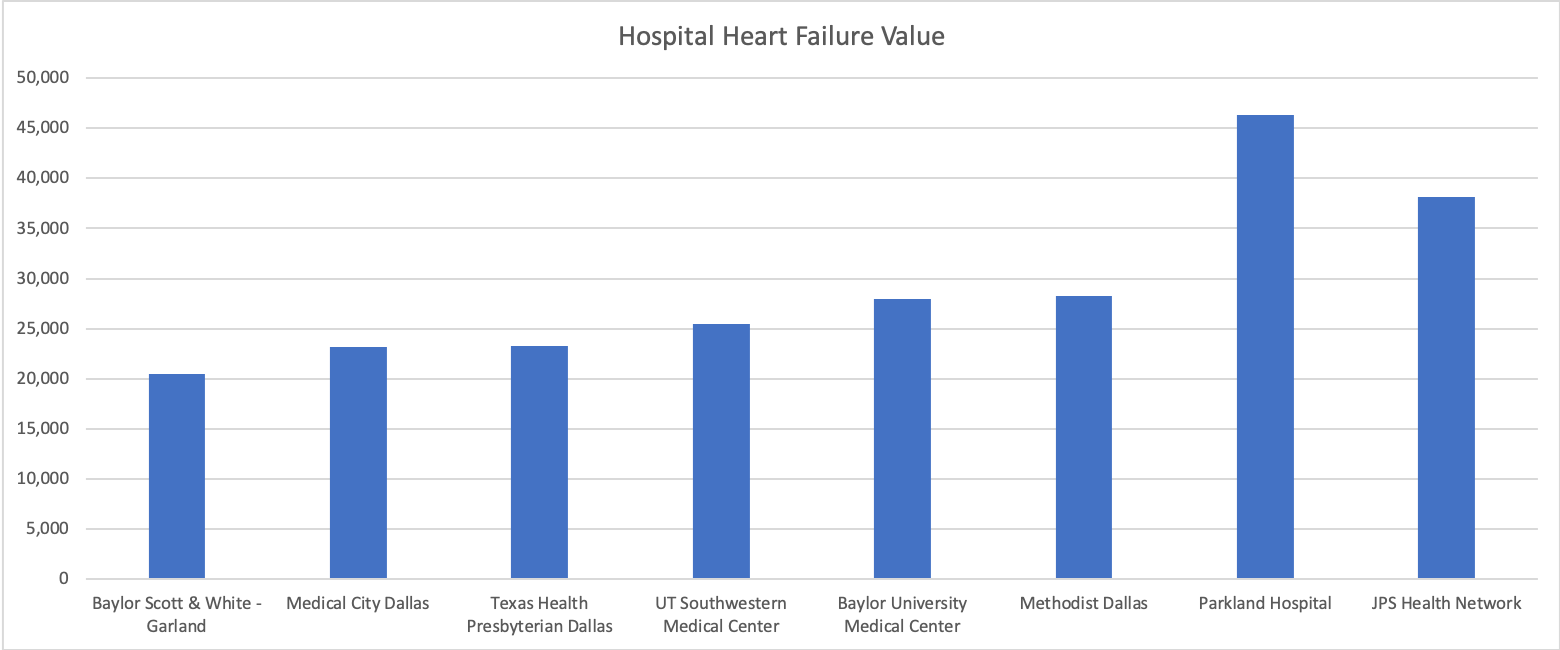Heart failure can cost between $20,435 and $46,332 in North Texas, according to claims database and analysis organization Dexur. Parkland Hospital is the most expensive in the region, though not the most expensive in the state, while now closed Baylor Scott & White Garland was the best value in the region.
Dexur aggregated the costs for episodes of care of heart failure claims between 2016 and 2019, factoring in the cost of hospitalization, re-hospitalization, emergency room costs, as well as nursing and home health costs. In order to adjust for comorbidities and complications, the data analyzed the hospital code “Heart Failure And Shock With Major Complication Or Comorbidity.” The report includes costs over an episode of care for heart failure, tracking the patients’ journeys from admission to 90 days later. The data accounts for value by calculating re-hospitalization rates and costs, penalizing a hospital that treats heart attacks inexpensively but results in a high number of re-hospitalizations. The data is meant to provide total cost of care so that patients and referring physicians can make decisions about value.
There are more expensive hospitals than Parkland in North Texas (Kindred Hospital in Arlington costs $56,000 per episode), but Parkland was the lowest value hospital with a meaningful sample size for the timeframe. As the safety net hospital for Dallas County, much of Parkland’s work is uncompensated care for those without insurance, meaning most Parkland patients don’t pay anything and society picks up the tab. In addition, Parkland’s patients are more likely to be impacted by the social determinants of health, meaning they have more health issues to start with and more obstacles to maintaining their health. Because the patient population is sicker and more difficult to treat in the first place, they are likely to be readmitted to the hospital or take a longer time to recover. JPS Health Network, the county hospital in Tarrant County was also on the high end, at $38,165.
In Dallas proper, Medical City Dallas, Texas Health Presbyterian Dallas, and UT Southwestern Medical Center are the three most valuable hospitals, ranging from $23,000 to $25,000 dollars for a 90-day episode of care. Readmission rates for these three hospitals was between 25 and 32 percent. The bulk of costs for these 90-day episodes of care comes from the original hospitalization and rehospitalization if it occurs, with emergency department, skilled nursing, and home health costs rounding out the total value.
The claims data also says that 25 to 27 percent of patients in these Dallas hospitals were discharged to home health services at a cost of $2,600 to $4,200, and between 10 and 28 percent of patients were discharged from the hospital to skilled nursing facilities at a cost ranging from $7,500 to $13,600.

Treating heart failure is not a scheduled procedure, and patients are usually brought to the nearest facility that can provide appropriate care, which is one reason there is so much variation in costs. Patients are not shopping for a hospital when they have a heart attack, they are at the mercy of geography and the ambulance driver, if they take one. This means hospitals are not feeling pressure from patients to lower costs for this procedure especially.
But understanding value for heart failure and other treatments can be helpful for those at risk populations, enabling them to make a plan with their primary care physician and family to head to the hospital with the best value should they experience a heart attack.
Everyone from insurance companies to the President has been making a push for increased transparency when it comes to hospital prices, and hospitals were mandated to publish charges for all procedures last year, but because the lists were difficult to decipher and didn’t factor in quality or insurance discounts, prices are practically meaningless for the average consumer. Most insurance companies have a tool to calculate costs at different facilities, but these tools are usually most effective for scheduled procedures, not emergencies.
Dallas-Fort Worth has some of the highest medical costs in the country, and heart failure is not the only procedure that has a wide value range. MRIs and knee replacements, which can be scheduled, can cost vastly different sums. Because of deductibles, copays, and a lack of price transparency, values for similar services can vary widely and the true costs are hidden from the average patient.
But as medical costs become more unsustainable, employers and payers are working to find value and reduce overall medical spending. Direct contracts, narrow networks, and addressing social determinants of health upstream are all strategies being employed to reduce medical costs in North Texas and around the country. Knowing how much things actually cost, who is reducing readmissions, and keeping quality high can help reduce spiraling medical costs.
Explore the data further here.






